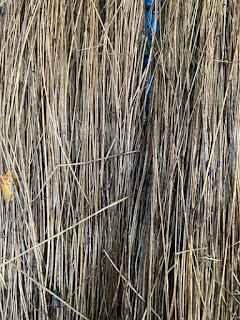Ret = Rot = Patience
So much has advanced with my ASI Teaching Tools Grant project! But today, I want to share some photos from my first attempt to pool-ret a flax crop. (My first attempt at retting flax occurred over a winter season as a "snow-retting" and left a great deal to be desired.)
A friend with a farm down the road gave me his dried, but not retted, flax crop which he grew as a test crop a few years ago. As the summer winds down, this gift has become a great opportunity to experiment with pool retting before diving into my potted flax crop processing. So, last Saturday, August 27th, I got out the puppy pool (a hard-sided, portable pool) and the entire gifted crop (just a few handfuls of flax stalks) to begin an experiment with retting the stalks.
First, an explanation of the word "ret." In Swedish, "ret" translates to "rot." And that is exactly what needs to happen to the outer matter of the flax stalk to allow the strong, spinnable fibers to be released from the stalk. Retting can be done by soaking the flax in a pond or stream (or a puppy pool), by laying it out in dewy grass for a few days to weeks, or through chemical means, which is a process left to commercial flax mills—although, ironically, chemicals, even though they are more controllable, are not an ideal way to ret it and can even damage the fiber. Flax likes to keep things close to the earth!
Fortunately, the pool was just the right size for the stalks.
I used bricks to keep the stalks submerged.
The process can take from 5 days in ideal, warm conditions, to perhaps 2 weeks. Our property is heavily wooded, so sunlight is not very available. Therefore, the pool water has remained cool to barely lukewarm. I think a warmer environment would be beneficial, yet I also consider areas of the world where flax is retted in streams and ponds, such as Ireland and Scotland, where a cool climate reigns. The retting will take longer in cooler waters, but it will still happen, so I'm not concerned. Let time do its thing!
Here is the retting flax after 3 days. The water has turned the color of English tea—and horribly stinky! You can see that the biological matter in the stalks is breaking down through the water's foaming. The foaming becomes even more dramatic as I exchange some of the water for fresh, which should be done every day to every few days.
I am testing the flax daily to see the retting progress. To do that, I pick out a stalk to bend and manipulate. You know the flax is ready to pull out of the bath when the outer skin starts sloughing off and revealing the flax "threads" beneath. I'll post photos of what that should look like when it happens. Today is the 5th day in the retting process, and the stalks are still quite intact. Patience is needed!
My next post will be an update on the flax pots and the ASI teaching tools grant progress. Much has happened in those areas. But for today, I will let retting flax ret!
































